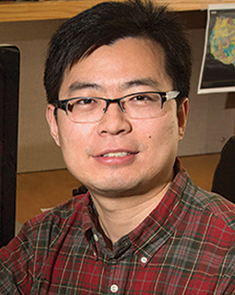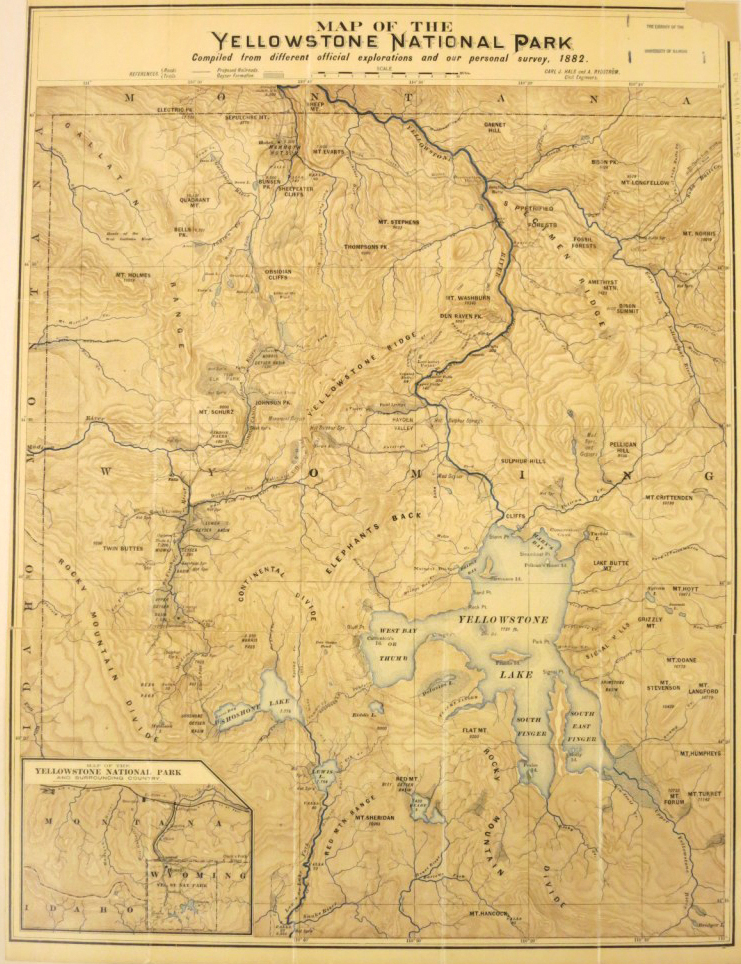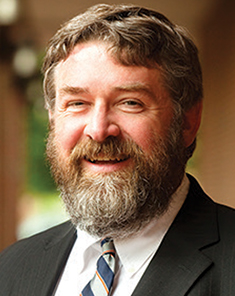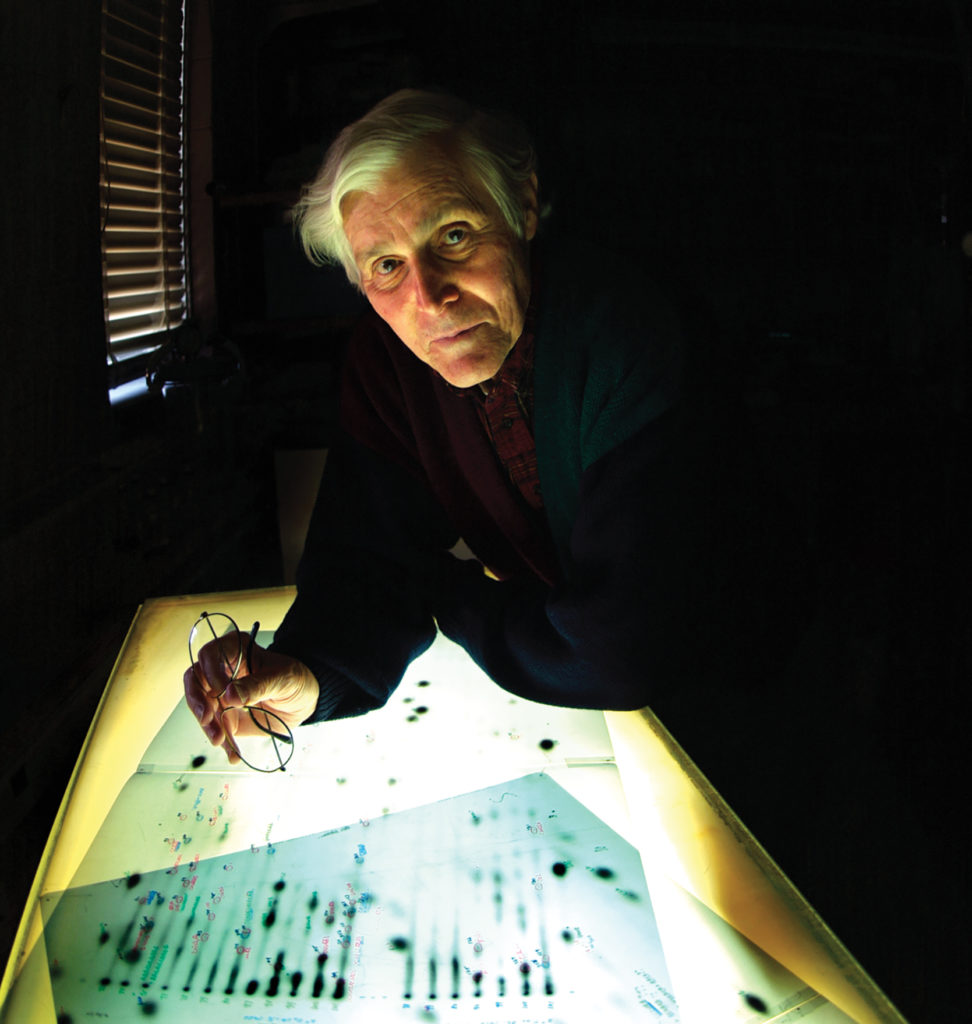Small Wonders
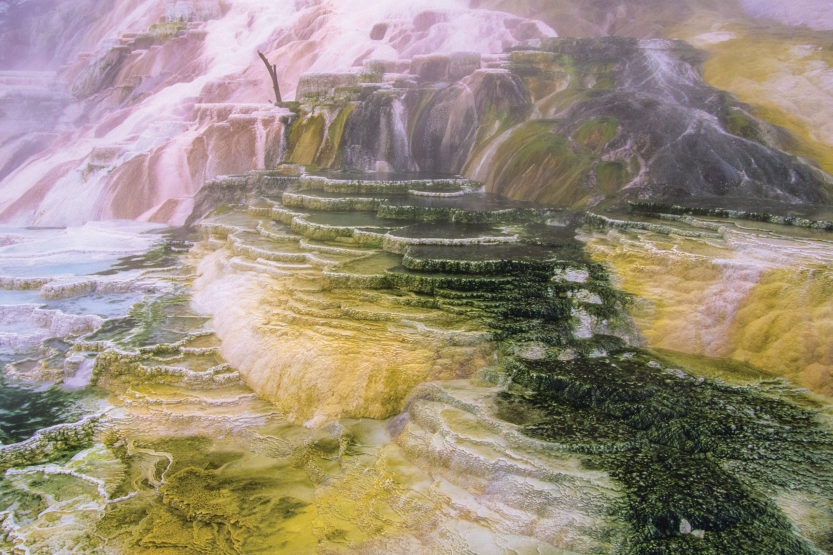 The Pallette Spring of Mammoth Hot Springs in Yellowstone National Park is a source of biodiversity similar to that found in coral reefs and rain forests, according to UI geobiologist Bruce Fouke. (Image by Tom Murphy)
The Pallette Spring of Mammoth Hot Springs in Yellowstone National Park is a source of biodiversity similar to that found in coral reefs and rain forests, according to UI geobiologist Bruce Fouke. (Image by Tom Murphy) The stones vault overhead to form a basalt arch, named for President Theodore Roosevelt, who laid the cornerstone in 1903. Soon the road starts to climb, switchbacking up and up, between the Gardner River and the cliffs the river has carved, jagged rock faces where bighorn sheep wander and feed. Crest the rise and enter Mammoth, Wyo., seat of Yellowstone National Park.
Mammoth is a place with potential as enormous as its name. For most visitors, it is the diving board into the park’s wonders—mountains and meadows, streams and lakes, waterfalls and geysers. Bears and wolves live here. So do elk, bison, coyotes, beavers—an ark’s worth of life forms, from large to small. Some are very, very small.
For University of Illinois geobiologist Bruce Fouke, Mammoth also is a jumping-off point leading to a vaster realm—one that reaches from the clouds to deep below the Earth and back up again into the intricacies of the human body and the mysteries of the universe. Fouke studies the hot spring terraces at Mammoth, where water that fell from the sky long ago now bubbles up from underground and courses downhill, leaving behind limestone in terraces both tall and tiny, enduring and ephemeral. This phenomenon is just one in Yellowstone’s extraordinary range of geysers, fumaroles and hot springs. The park’s location over an ancient supervolcanic caldera grants it more than 12,500 hydrothermal features, outnumbering those of any other site in the world.
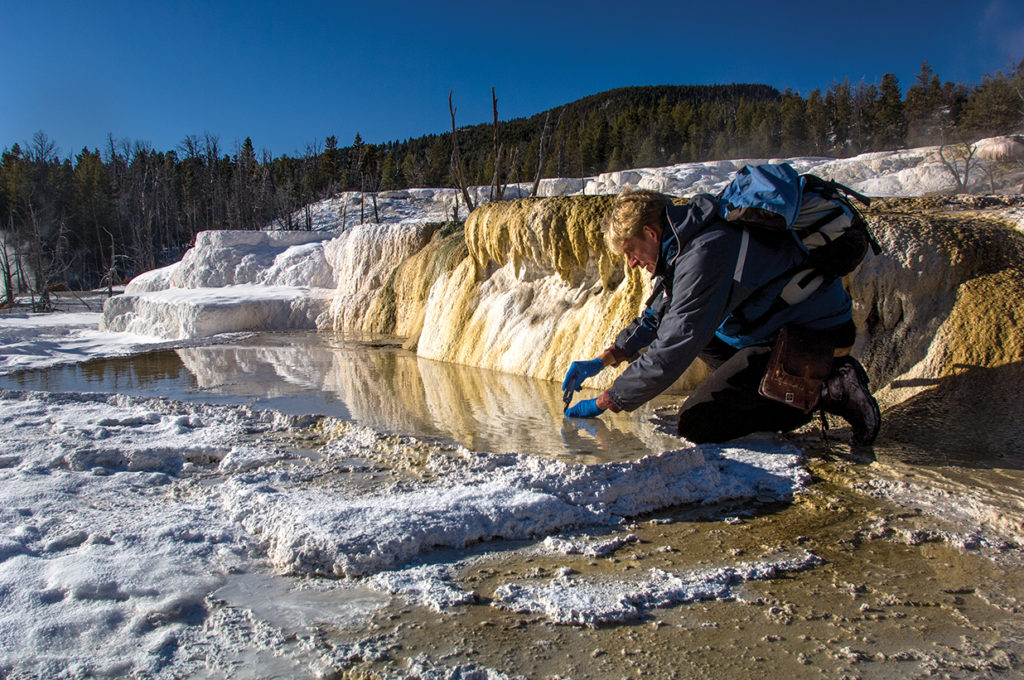
“The very first life on Earth started about 4.3 billion years ago,” says Fouke, seen here working in the terraces at Mammoth Hot Springs. “Guess what they were? Bacteria living in hot water.” (Image by Tom Murphy. Research conducted under Yellowstone Research Permit YELL-SCI-2008-3060)
Limestone forms where flowing water acts on layers of sediment and rock to create calcium carbonate (CaCO3). At Mammoth Hot Springs, that CaCO3 limestone—better known as travertine—is forming faster than usual. Like, a billion times faster. Ask how this could be, and Fouke has a two-word answer: Sulfurihydrogenibium yellowstonense. It’s a bacterium that lives deep among the rocks. It rides to the surface on water super-heated by magma and reacts with oxygen and sulfur at the surface to create travertine. Sulfuri is but one of an as-yet-uncounted array of heat-loving bacteria, archaea and algae—life forms known collectively as microbes—that live among rocks in the Earth’s outer crust and are found in the thermal features of Yellowstone.
“The very first life on Earth started about 4.3 billion years ago,” says Fouke. “Guess what they were? Bacteria living in hot water. And guess what they are directly related to? The microbes that live in Yellowstone. You can stand and look down at the spring. You see water flowing, you see microbes growing, you see rock growing. And it’s exactly the natural setting present during the earliest period of Earth’s history, when life first evolved.”
Window on the universe
At 6 feet, 8 inches tall, Fouke cuts a figure suited to the rugged nature of his research. Yet he’s also much at home in his campus office at the Institute for Genomic Biology, which overlooks the agricultural buildings of the South Quad. His office is arrayed with rock samples from his decades of field work and exploration. His face is craggy and his eyes glow with warmth, humor and wonder as he talks about what he does. His words flow prolifically—by his own simile, “like a hot spring.”
“Yellowstone is a window on the universe,” Fouke says. “It’s an incredible natural laboratory that lets us, by studying it, understand processes that control so much throughout the cosmos: the basics of evolution; the ability to track and understand water quality and purity; the impact of climate change; space exploration.”
Fouke has been familiar with Yellowstone for most of his life. As a child, he spent summers there when his father, a Methodist minister, was stationed there as a park chaplain. The family home was in rural Iowa, where Fouke grew corn and beans and raised hogs, and found the occasional chunk of fossilized coral-rich limestone lingering from when vast inland seas covered the Midwest.
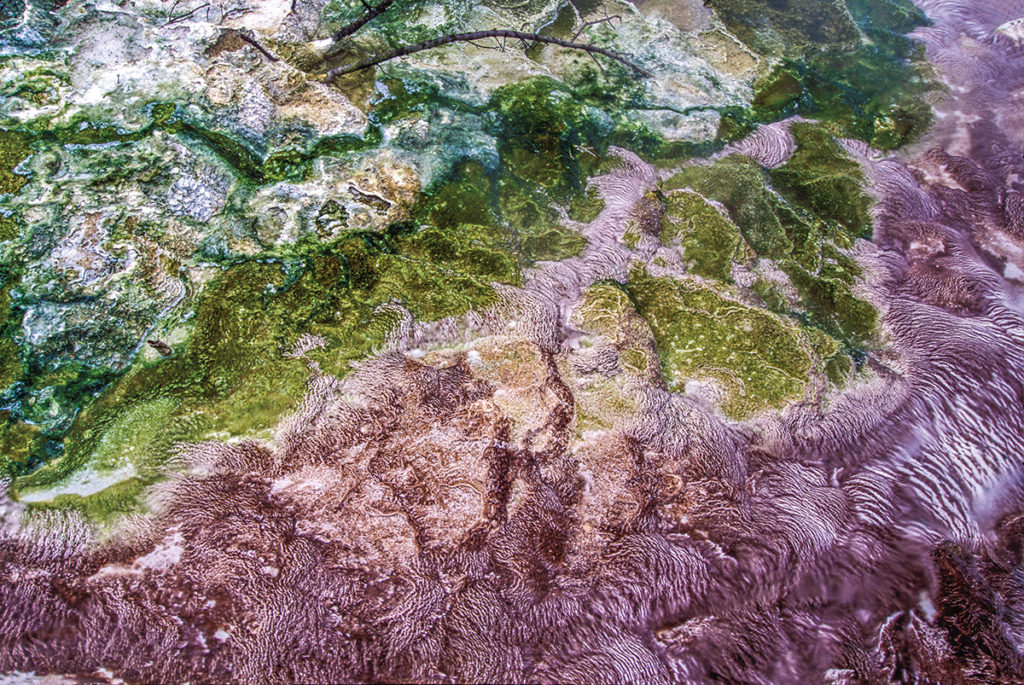
Limestone forms where flowing water acts on layers of sediment and rock to create CaCO3—better known as travertine. At Mammoth Hot Springs, it’s forming faster than usual—more than a billion times faster due to a bacterium that lives deep in the rocks. (Image by Tom Murphy)
In his junior year at Bradley University in Peoria, Ill., Fouke became entranced by the images of “volcanoes and mountains and oceans and ice sheets” he saw during a lecture on earth science; he promptly changed his major from civil engineering to geology. Graduate school at Stony Brook (N.Y.) University led to a stint in the Caribbean studying coral reefs—which are, like the Yellowstone terraces, calcium carbonate structures built by living organisms. He then worked at the Free University in Amsterdam on the biosignatures of reefs around the world—the story left behind by generations of microbes in layers of coral. From there, it was an improbable but productive leap to Berkeley, Calif., and postgraduate research on what happened to the dinosaurs.
“I worked with planetary scientist Walter Alvarez on the meteor that killed the dinosaurs,” Fouke says, pointing to a shelf containing a cobble of red limestone he retrieved from the vicinity of the Chicxulub meteor crater. “The impactor hit an enormous coral reef growing on the Yucatan Peninsula. It was traveling at 160,000 miles per hour. Within 30 seconds, it made a hole 200 miles wide by 3 miles deep. Living and ancient fossilized coral reefs at the site were immediately destroyed. All that rock debris and chemistry were launched into the atmosphere, where they obscured sunlight and prevented photosynthesis. That was the nail in the coffin regarding the demise of the dinosaurs.”
From Berkeley, it was on to a stint at NASA’s Ames Research Center in Mountain View, Calif., where the space agency was working on its 1996 Pathfinder mission to Mars. Fouke studied the geologic connections between fossils in coral reefs and evidence of life on other planets. Seeing that coral and travertine have much in common—both are made of CaCO3 and both form in salty water—he decided to look for more answers at Mammoth Hot Springs.
The beginning of his research at Yellowstone came shortly before he joined the UI faculty in 1997. Within days of his arrival on campus, he had met microbiologist and biophysicist Carl Woese, a towering genius whose work at Illinois radically changed the direction of evolutionary theory. (See sidebar.) “When I first talked to Carl,” Fouke says, “the incentive was to say, ‘I work on coral reefs and hot springs, and I know that microbes are important. But I don’t have any background. Would you help me meet people to do that?’ And he hit me with a question that changed my life. For Carl it was, simply put, ‘Okay, so you’re a geologist. What’s the problem with learning some microbiology? Are you up for it? Why wouldn’t everyone do that?’ ”
With microbiologist Abigail Salyers, Woese went on to mentor Fouke. They allowed him to work in their laboratories and patiently guided him through the basics of a whole new discipline. And with that, Fouke says, “the research just exploded.”
Limitless potential
Microbes are everywhere on Earth—including in people, where they make up an estimated 90 percent of the body’s cells. Continuing study of the “microbiome” reveals important information about the colonies of bacteria that live within human beings and assist in digestion and fighting off disease. In nature, microbes perform photosynthesis, absorb carbon dioxide, and eat elements such as sulfur and salt. Harnessed by manufacturing and medicine, they create enzymes, impel fermentation, clean up waste and produce medications.
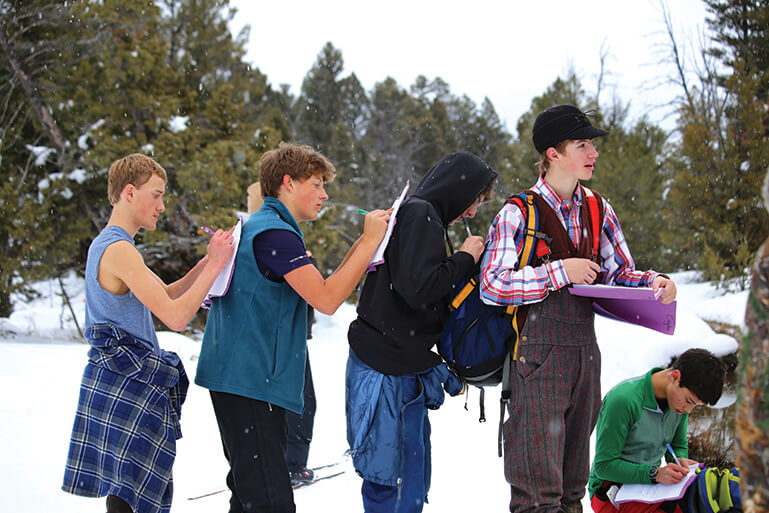
Each year, Illinois undergraduate students participate in research at Mammoth Hot Springs. (Image Courtesy of Bruce Fouke)
The potential and importance of microbes can’t be overstated. Thermus aquaticus, informally known as Taq, was discovered in Yellowstone’s Lower Geyser Basin in 1966. Taq provided the molecular template for polymerase chain reaction, also known as PCR, a laboratory technique that amplifies copies of DNA segments. PCR led to the field of genomic research, reducing the time needed to analyze genomes from years to hours and spawning a trillion-dollar industry.
Fouke views PCR as “the single most valuable technological discovery made thus far. From the human genome to synthetic medicine, it’s in every sector,” he says. “It’s in oil and gas exploration. It’s in water quality. It’s a core piece of astronaut safety, all the way to looking for life on other planets.”
Coral reefs to kidney stones
Fouke’s own work wends and arcs in an eclectic and fascinating journey. In addition to the hot springs in Yellowstone and the coral reefs of the Caribbean, he has studied Roman aqueducts (which have their own deposits of travertine), helped create a database for managing Yellowstone research and published prolifically in scholarly journals. He teaches undergraduate courses—including a massive open online course (MOOC) with enrollments that top out at 50,000 each year—and has guided more than 1,000 UI students on field trips to Yellowstone’s hot springs and the southern Caribbean’s coral reefs. Fouke serves as director of the University’s Carver Biotechnology Center, which provides scientists at Illinois with instruments and computing resources for the analysis of DNA, RNA and living cells.
Fouke and M.D./Ph.D. student Jessica Saw are collaborating on research with the Mayo Clinic on human kidney stones. The team is investigating conditions under which calcium oxalate stones precipitate in the kidney, a process that has similarities to the formation of both travertine and coral skeletons. The goal is to discover whether kidney stones can be dissolved in the body, potentially offering an alternative to the painful options of passing the stone or undergoing surgery.
Such research resonates with the astounding scalability of microbial life in many different environments—including the Earth’s outer crust, where the vast majority of microbes reside. “This idea of drilling holes in the ground, extracting oil and gas and then pumping down deadly toxins or sewage or waste or radioactivity,” says Fouke, “means we’re polluting and destroying the greatest reservoir of biodiversity we have on the planet.”
All life has poured forth from microbes. The trout, trees, elk, wild grass, butterflies—the countless animals and plants of Yellowstone and of the world come from far-distant ancestors of tiny creatures living in boiling water and rocks. And the organization of this family tree could apply to life elsewhere in the solar system and the universe.
This cosmic diversity is the subject of The Art of Yellowstone Science, a book published in 2016 by Fouke and nature photographer Tom Murphy. Paired with Murphy’s spectacular images of the park’s thermal features, landscapes and wildlife, Fouke’s text takes the reader through geologic time and evolutionary science toward an understanding of how the wonders of Yellowstone resound far beyond its natural beauty and intriguing creatures.
“PCR, one of the single most potent economic machines ever developed by humankind, came from a hot spring in Yellowstone,” says Fouke. “That was made possible only because Yellowstone had been protected by the National Park Service. If it hadn’t been, those organisms would have been wiped out or fundamentally altered to the level that they probably would never have been found. For even the deepest naysayers, we have an answer. If you really want money in the future, if you want jobs in the future, we must protect these natural spaces. They hold the key to the solutions of the future.”
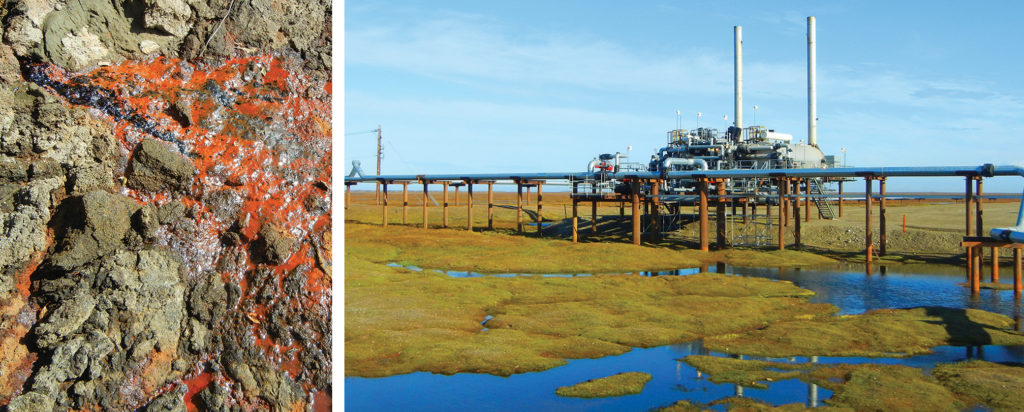
Left: Orange microbial mats metabolize heavy oil. Understanding how microbes break down hydrocarbons will lead to practices that help preserve the deep microbial biosphere. Right: Research at Mammoth Hot Springs is yielding information about the deep subsurface biosphere, which will result in more efficient and environmentally sustainable oil and gas extraction in places such as the Arctic tundra (shown here). (Images courtesy of Bruce Fouke)
Amid the nation’s tug-of-war over natural resources, which veers between preservation and exploitation, Fouke’s argument is compelling. And it isn’t new. In the 1872 act that created Yellowstone, the U.S. Congress summed up the value of nature with a strong, simple phrase. These words endure in the stones of the arch that heralds one of the most fabulous wildernesses areas in the world. They proclaim Yellowstone to be “For the Benefit and Enjoyment of the People.” It was a principle to live by in 1872, as it is now, and will be (in the work and hope of Bruce Fouke) forever.
Yellowstone Connections
UI research in national park ranges across disciplines
Geology
Geology Professor Lijun Liu has addressed the possibility of a volcanic catastrophe at Yellowstone. The park sits on a huge caldera; it has long been thought to be at risk for earthquake and supervolcano eruption brought on by a rising subsurface material known as a mantle plume. Using the Blue Waters supercomputer, Liu and his team of graduate students modeled the region’s subsurface geology based on seismological data. The results show that the heat that fuels Yellowstone comes from beneath the Pacific Ocean rather than from a mantle plume.
History
Even the University Library has a Yellowstone connection: a rare copy of the first tourist map of the park, created by Northern Pacific Railroad engineers and published in 1882. It includes illustrations and a commentary titled “Alice’s Adventures in the New Wonderland.”
Political Science
Robert Pahre, professor of political science, offers an undergraduate class on the politics of the greater Yellowstone area. Students spend almost two weeks in Yellowstone and Grand Teton National Park, learning about the policy challenges the parks face. Course topics range from tourism and the meaning of wilderness to how the movements of animals across boundaries (such as wolves and bison venturing outside the parks) create tensions in the community. Pahre’s research deals with how humans relate to nature, and how humans relate to one another in natural landscapes such as Yellowstone and other national parks.
Microbiology
UI Microbiologist Rachel Whitaker studies microbes in the hot springs of Yellowstone, where much of her research focuses on Sulfolobus islandicus, an archaea found in acidic streams and pools. Last year, she received the Allen Distinguished Investigator Award—a prestigious international honor funding research on viruses and evolution—supporting her future work investigating regions of the genome capable of moving rapidly between cells, hastening genetic change.
Sociology
Norman Denzin, emeritus professor of sociology, is the author of Searching for Yellowstone: Race, Gender, Family and Memory in the Postmodern West. In this work, published in 2008, Denzin writes about how living near Yellowstone shaped his views on such topics as the Lewis and Clark expedition, tourism and 21st-century representations of Native Americans.
Carl Woese Remembered
Long-time Illinois faculty member transformed biology and evolutionary theory
Carl R. Woese (1928-2012) is immortally linked to his discovery of single-celled organisms called archaea. But Woese did much more than this to upend and restructure taxonomy and evolutionary theory. A biophysicist and microbiologist, Woese joined the University of Illinois faculty in 1964. His intensive study of DNA and RNA led him and his collaborator, postdoctoral researcher George Fox, to advance the then-controversial argument that the universal tree of life consists of three branches: bacteria, archaea (both microbial life forms) and eucarya (complex life forms, including humans). Even more revolutionary was their idea that genetic mutations can be shared laterally (within generations) as well as vertically (from generation to generation, according to the Darwinian model). Woese based these findings on years of painstaking manual molecular sequencing using X-rays of DNA.
Woese and Fox proposed archaea as the third domain of life in 1977, having first found them in the stomach of a cow on the UI campus at the College of Veterinary Medicine. The researchers went on to confirm the existence of archaea, using 16S RNA gene sequences collected in Octopus Spring—a hydrothermal feature in Yellowstone National Park. The Carl R. Woese Institute for Genomic Biology at Illinois was renamed in his honor in 2015.—M.T.

